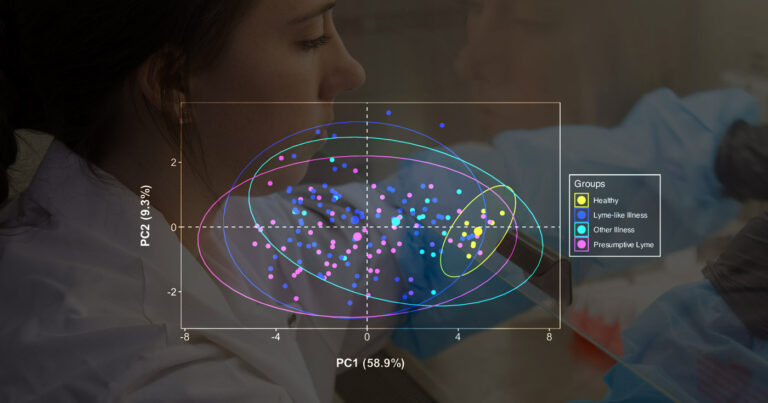Research confirms presence of Borrelia cyst-like structures after antibiotic treatment and uncovers a unique localization of Borrelia species in the brain
Research continues to reveal an increasingly complex picture of Lyme disease.
Insert HTML here

Research continues to reveal an increasingly complex picture of Lyme disease.

Keeping neurological symptoms and Lyme rashes on the radar.

Examining serology and the health burden of Lyme disease and chronic illness with Victoria Sanderson at the G Magnotta Lab.
Abstract The tick, Ixodes scapularis, vectors pathogens such as Borrelia burgdorferi, the bacterium that causes Lyme disease. Over the last few decades I. scapularis has expanded its range, introducing a novel health threat into these areas. Warming temperatures appear to be one cause of its range expansion to the north. However, other factors are also involved. We show that…
“Why You Should Listen” “In this episode, you will learn about groundbreaking work being done to move the needle in understanding the impact of Borreliosis.” Listen to podcast
July 29, 2022 Abstract The blacklegged tick, Ixodes scapularis, vectors Borrelia burgdorferi, a bacterium that causes Lyme Disease. Although synthetic pesticides can reduce tick numbers, there are concerns about their potential effects on beneficial insects, such as pollinators. Plant-based pest control agents such as essential oils could provide an alternative because they have low environmental persistency; however,…
By Pamela Weintraub “Many physicians who treat tick-borne diseases now combine conventional medicine with gentler integrative strategies — and more long-term patients are getting well. In the summer of 1997, Jennifer Crystal discovered a red, splotchy rash on her arm. A 19-year-old counselor at a camp in Maine at the time, Crystal had grown up…
May 25, 2022 Good Documentary by a News Reporter that has Been Through it Herself Watch full video
[CanLyme Note: We disagree that “appropriate treatment” has been established for borreliosis. Also, this study involved deceased monkeys and is a primary tissue study so it is not representative of what occurs in a living human. There are interesting point made including that dead borrelia remnants can cause havoc.] Abstract Even after appropriate treatment, a proportion…
Abstract Introduction. Because patients with a suspicion of Lyme borreliosis (LB) may have experienced difficult care paths, the Tick-Borne Diseases Reference Center (TBD-RC) was started in 2017. The aim of our study was to compare the clinical features of patients according to their final diagnoses, and to determine the factors associated with recovery in the…
Abstract By using commercial insurance claims data, we estimated that Lyme disease was diagnosed and treated in ≈476,000 patients in the United States annually during 2010–2018. Our results underscore the need for accurate diagnosis and improved prevention. Lyme disease is caused by Borrelia burgdorferi spirochetes, which are transmitted to humans by certain Ixodes spp. ticks (1). The infection can…
Sarah explores the latest advances in Lyme disease treatment with Dr. Kim Lewis, a researcher, author, University Distinguished Professor and director of Antimicrobial Discovery Center at Northeastern University in Boston. He specializes in molecular science and is currently researching persister cells that lead to tolerance to antibiotics, uncultured bacteria of the environment and the microbiome…
October 29th, 2021 Victoria P Sanderson 1, Iain L Mainprize 1, Lisette Verzijlenberg 1, Cezar M Khursigara 2, Melanie K B Wills 1 Abstract Serological diagnosis of Lyme disease suffers from considerable limitations. Yet, the technique cannot currently be replaced by direct detection methods, such as bacterial culture or molecular analysis, due to their inadequate sensitivity. The low bacterial burden in vasculature and lack…
“In today’s podcast, Sarah speaks with Victoria Sanderson about her exciting new research into Lyme disease testing at the University of Guelph. Sanderson is a current medical student and previously completed her Master’s degree at the University of Guelph and became interested in Lyme disease after seeing how much the disease impacted her mother’s life and…
Dr. Schwarzbach is a specialist in laboratory medicine and infectious diseases, having worked in the field for over 20 years. He recalls one of his patients who was diagnosed with Multiple Sclerosis and tested positive for a test that was then called a lymphocyte transformation test for Borrelia burgdorferi even though she subsequently tested negative for antibodies…